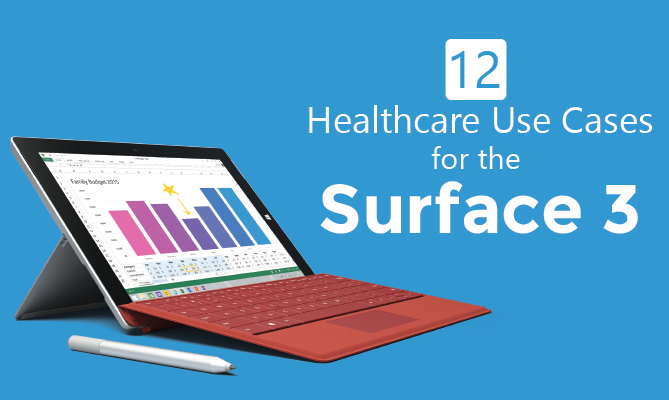Healthcare Use-Cases for Microsoft Surface 3

Earlier this year, Microsoft released a new version of their famous Surface devices, the Surface 3. The new laplet is jam packed with features and functionality including:
- 10.8 inch touch-screen display
- Quad Core Intel Atom(TM) processor
- 2 GB RAM Memory,
- 64 GB Flash Memory
- 1.37 pounds
- 10 hours of video playback
- 3.5 megapixel front-facing camera
- 8.0 megapixel rear-facing camera with auto-focus
- 4G LTE
- Runs desktop version of Windows
- Surface pen compatible
I’ve written in the past about how the Surface is a perfect computer for nursing students. But what about for practicing nurses? This got me thinking…
Home Health Wound Care Nurse
One particular healthcare use-case that could see the full potential of the Microsoft Surface 3might be a Home Health Wound Care nurse or nurse practitioner (NP).
This nurse would benefit from the portability and LTE capabilities, by using it to navigate to her patient’s house (GPS/Maps), access the EHR remotely (LTE), and carry it to and from her car (light weight). Part of wound care is taking pictures (Surface 3 rear facing camera) of wounds at each appointment to track healing over time, and importing these pictures in the EHR. These pictures also should be annotated (Surface Pen) by drawing lines around the parameter to measure changes.
It’s also possible that the Wound Care Nurse would want to consult with a Dermatology Physician or NP, and she could use the front-facing camera for telemedicine consultation. What if the patient spoke a different language? The nurse could use the Surface to connect with a remote translator. Finally, the Surface 3 would need to be cleaned after each home visit (sanitizable).
And, 11 More Healthcare Use-Cases for the Surface 3
- Shift Reporting: At change of shift, the nurse from the previous shift explains to the new nurse everything about the patient. During this time, the new nurse is usually quickly writing down everything onto a piece of paper that she then drops in her scrub pocket. Instead she could use the Surface 3 and Surface Pen to write everything down.
- Patient Dashboard: Nurses could use it as their own patient dashboard. The screen would display each of their patients and the most pertinent information (name, diagnosis, reason for admission, lab results, vitals, pain score, etc.).
- EMR Documentation: Nurses could use the Surface 3 to document in the EHR
- Tracking Hospital Acquired Conditions: Many medical-surgical units have dry erase boards in the break room where they track the frequency of hospital acquired conditions (C. diff, MRSA, falls, etc.) on their unit. The nurse manager usually sets a goal and develops quality improvement initiatives. Could use the Surface 3 for tracking and monitoring this data.
- Monitoring Patients: At the nurses station, there are usually computer monitors that display live patient information (vital signs, ECG heart rhythms, EEG-video monitoring). Making this information available to nurses who aren’t standing in the nurses station would be valuable. For example, if a nurse is down the hall in another room, she could still quickly check on her other patients by look at her Surface 3.
- Picture Taking: As mentioned above, using the rear facing camera to track and document progress on dermatologic conditions (wounds, rashes, burns, etc.).
- Nurse-Patient Relationship/Education: The nurse could use the surface to educate patients at the bedside or show them their health information (such as X-rays). The nurse could also use the Pen to jot down notes while the patient is talking to her (as opposed to typing on a computer), which would facilitate better communication.
- Standardized Forms: Nurses frequently have to fill out standardized assessments (PHQ-9 for example). These could easily be made electronic, and filled out by the nurse using the Surface 3 at the bedside.
- Telemedicine: As mentioned above, nurses could use the Surface 3 front facing camera to consult with other providers or other nurses in the hospital.
- Language Translation: The Surface 3 could be used to connect with remote translators. (My previous hospital used iPads mounted on poles for this… So silly because everyone had a laptop, but there was only one iPad translator per unit…).
- Alarms: A big problem on nursing units is noise. There are sounds coming from everywhere: bed alarms, pulse ox alarms, ECG machines, etc. When an alarm is triggered, a loud beeping noise is projected through the entire unit to alert the patient’s nurse (wherever she may be at that moment in time). Maybe the Surface could be used to alert the correct nurse more quietly: possibly vibrate or make softer noises.
What do you all think? How could the Surface 3 be used on your units to improve patient care? As always comment below or feel free to message me.
Share on Facebook Share on Twitter Share on Pinterest
0 Comments on "Healthcare Use-Cases for Microsoft Surface 3"